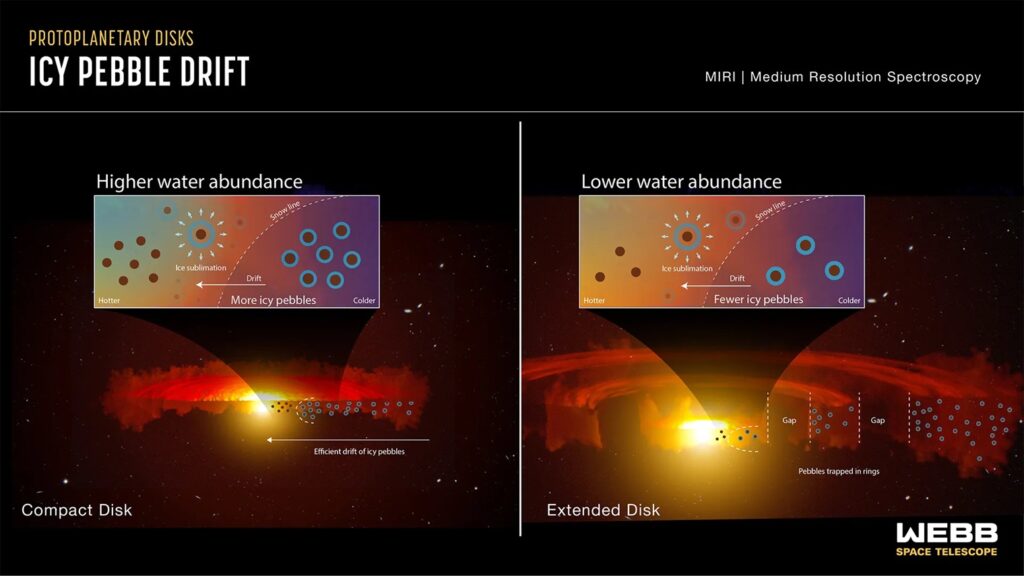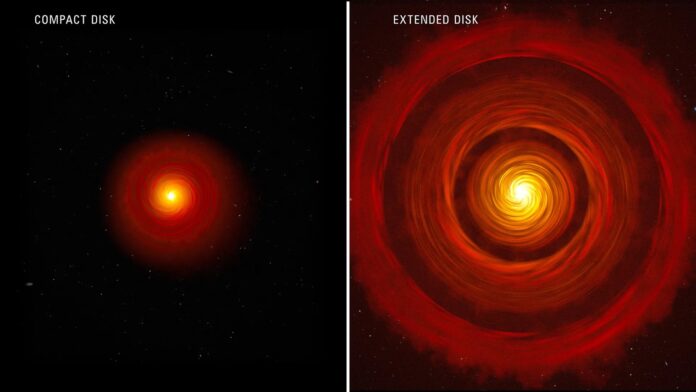NASA’s James Webb Space Telescope has helped scientists make a groundbreaking discovery about planet formation. By studying water vapor in protoplanetary disks, Webb confirmed that ice-coated solids drift from the disk’s outer regions into the rocky planet zone.
According to theories, ice pebbles in the cold outer regions of protoplanetary disks hold the fundamental seeds of planet formation. These theories’ primary predicate is that friction in the gaseous disk causes pebbles to move inward toward the star, supplying planets with both solids and water.
This theory’s primary prediction is that icy pebbles should emit a lot of cold water vapor when they move into the warmer area within the “snowline,” where ice turns into vapor.
Webb strictly observed this: It revealed the connection between water vapor in the inner disk and the drift of icy pebbles from the outer disk.
Team member Colette Salyk of Vassar College in Poughkeepsie, New York, said, “In the past, we had this very static picture of planet formation, almost like there were these isolated zones that planets formed out of. Now, we have evidence that these zones can interact with each other. It’s also proposed to have happened in our solar system.”
Using Webb’s MIRI, scientists studied four disks: two compacts and two extended—around Sun-like stars. All four stars are estimated to be between 2 and 3 million years old, just newborns in cosmic time.
The two compact disks are anticipated to undergo effective pebble drift, bringing the pebbles to within a radius similar to Neptune’s orbit. On the other hand, the extended disks are believed to maintain their pebbles in several rings out to a distance of up to six times Neptune’s orbit.
The findings validated the hypothesis by demonstrating that the compact disks had more cool water than the large disks.
Pebbles drifting in space tend to collect at pressure bumps caused by planets. Large disks with rings and gaps provide evidence for this phenomenon. Research suggests that pebbles gather in rings of increased pressure caused by giant planets. Jupiter may have served a similar purpose in our solar system by preventing water transport and pebbles to our minor, inner, rocky planets that receive comparatively little water.
At first, the data puzzled scientists.
Principal investigator Andrea Banzatti of Texas State University, San Marcos, Texas, said, “For two months, we were stuck on these preliminary results that were telling us that the compact disks had colder water, and the large disks had hotter water overall. This made no sense because we selected a sample of stars with similar temperatures.”

The explanation became evident only when Banzatti overlaid the compact disk data on top of the large disk data: the compact disks contain additional cold water just inside the snowline, around ten times closer than Neptune’s orbit.
Banzatti said, “Now we finally see unambiguously that the colder water has an excess. This is unprecedented and entirely due to Webb’s higher resolving power!”
Journal Reference:
- Andrea Banzatti, Klaus M. Pontoppidan et al. JWST Reveals Excess Cool Water near the Snow Line in Compact Disks, Consistent with Pebble Drift. The Astrophysical Journal Letters. DOI: 10.3847/2041-8213/acf5ec
